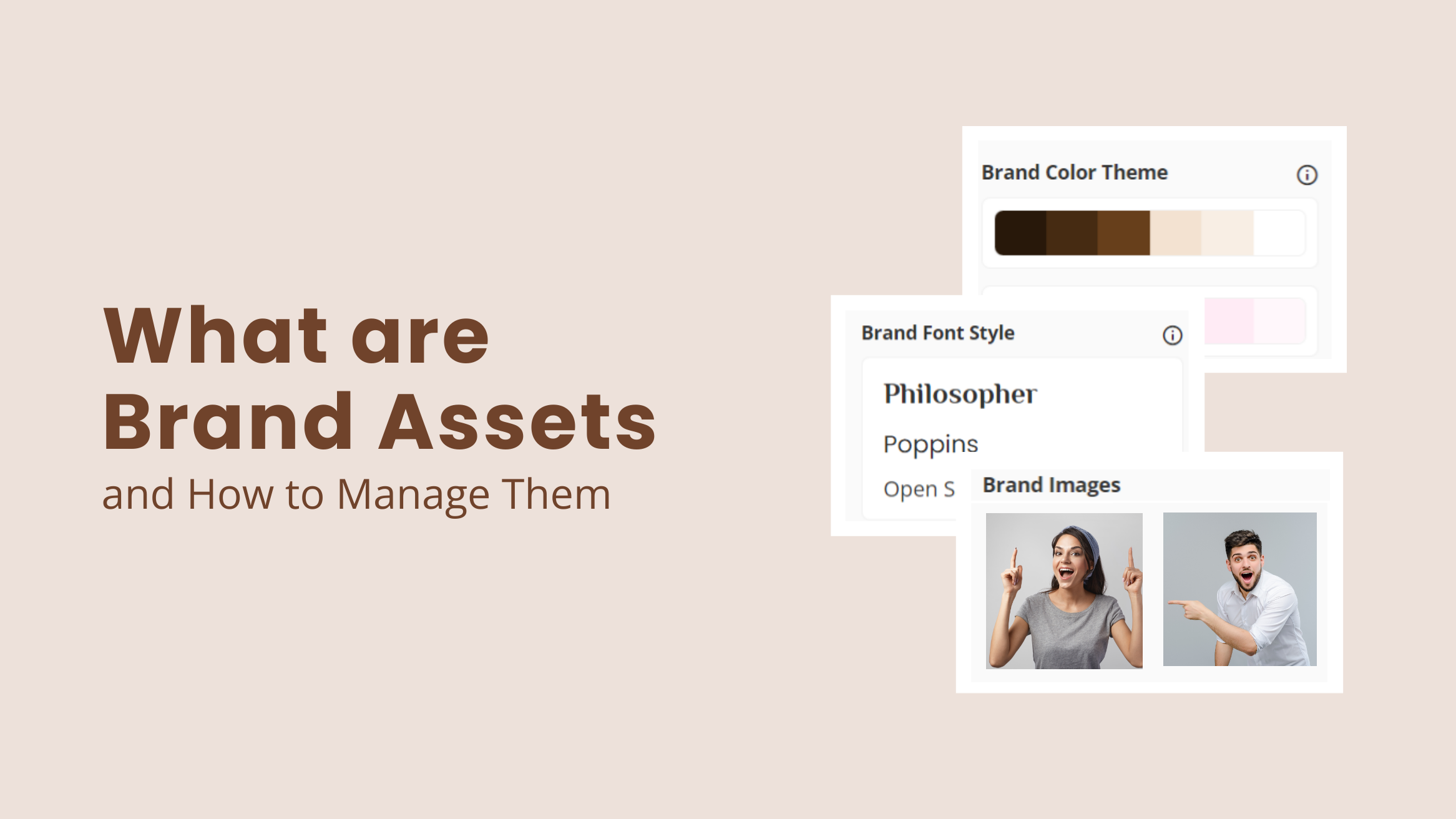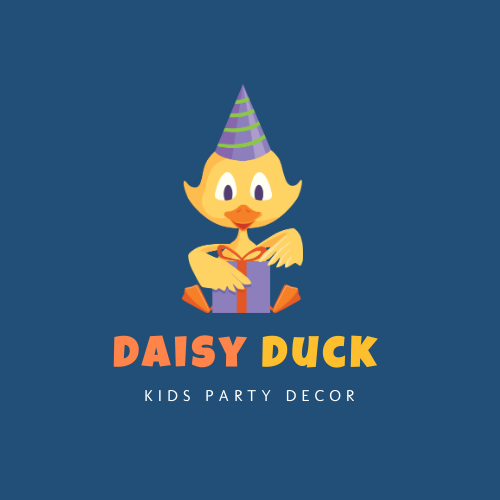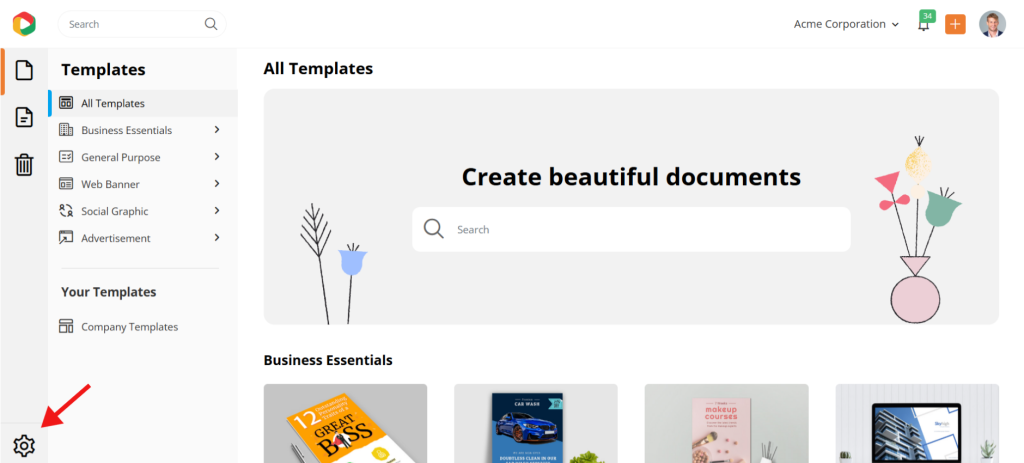
What are Brand Assets and How to Manage Them

What comes to mind when thinking about Cadbury, Audi, and Nescafe? For Cadbury, it’s the rich purple wrapper; Audi has the iconic rings in the logo and the typeface of Nescafe (along with the smell of hot coffee). These brands have made a mark on the audience with the help of their brand assets. So, what are brand assets?
Brand assets help build a brand’s identity so customers immediately recognize its products, services, and message. Building a brand’s persona depends on the brand’s assets. Yet, portraying your brand story with the right assets can be challenging.
What are Brand Assets
Brand assets are the essential components of a brand that enable customers to identify and embody its essence. The major elements of brand assets are:
- Brand Name: Catchy, relevant, and easy to remember.
- Logo: Simple and recognizable symbol.
- Colors: Relatable colors for the brand’s product, service, or niche.
- Fonts and Typography: Legible font that goes well with the meaning of the text.
- Images: High-quality and on-point images for maximum impact.
- Video: High-quality videos of products, user experiences, or scripted ads.
- Audio: Catchy jingle, tune, song, or voiceover.
- Slogan or Tagline: Helps to make emotional connections and is easy to remember.
- Mascots or Brand Characters: Portray the brand’s personality.
- Packaging: Shapes the perception of the brand for the customers.
- Brand Tone: Conveys a brand’s values and personality.
- Graphics: Creative icons, stickers, patterns, and illustrations.
Read further to learn more about managing brand assets.
In this guide, learn all about brand assets, including their definition, elements, and management. You will also learn the fundamental differences between brand assets, identity, and elements. In addition, real-life examples and templates will help you gain insight into creating the right assets for your brand.
Table of Contents
What are Brand Assets
Brand assets are the essential components of a brand that enable customers to identify and embody its essence. These assets create a unique brand identity when strategically integrated, setting it apart from competitors and resonating with consumers.
As consumers, we come across a variety of brand choices. However, our brain subconsciously processes various cues when selecting a particular brand, such as colors, brand tone, motto, etc. Brand assets play a crucial role in this process, conveying a sense of familiarity unique to a particular brand. Therefore, brands strive to keep each asset exclusive to them.
Why do You Need Brand Assets
Brand assets are instrumental in establishing a solid presence in the competitive market space. Moreover, multiple reasons exist for creating brand assets, such as increased distinctiveness, ROI, trust, and authenticity. Here are the different ways in which the assets help your brand:
Establish Brand Identity
First, brand assets help in building a brand’s identity. The colors, logo, symbols, packaging, and sometimes characters help us associate with a brand. We remember Apple’s logo, Nike’s tagline, and Coca-Cola’s iconic red color. These are the brand assets based on firm brand guidelines stating specifications about logo size, hex color code, typography, etc.
Maintain Brand Consistency Across Platforms
Maintaining brand consistency helps build authenticity. The world’s most popular brands use the same assets for years, seldom changing their branding. And it pays off, as 88% of people prefer to choose a brand based on authenticity. Most brands try to maintain transparency as proof of authenticity.
Build Trust of the Brand For Consumers
Around 59% of consumers prefer to buy products from familiar brands. Trust in a brand is one of the most important factors behind a consumer’s choice. When you ask why 89% of customers prefer to shop from Amazon rather than any other e-commerce platform, it’s because of the trust in the brand. Amazon has built a reputation for premium service and customer satisfaction.
Other ways a brand can build trust in the brand are by ensuring the privacy of the consumer, transparency about the price structure, and showing accountability for shortcomings.
Increases Brand Awareness and Engagement with Customers
Brand assets also help create awareness about the brand. In the initial stages of brand establishment, you want consumers to learn about your brand for the right reasons. The fixed guidelines about your elements help maintain consistency, thus increasing the chances of creating awareness about your brand. Once you have become aware of an authentic brand, the narrative should help increase customer engagement.
Improve ROI for the Business
When H&M and Zara announce their new collection, the customers follow through. Familiarity with the brand helps the customers persuade them even with minimum exposure. Therefore, they have to spend less on marketing with huge returns to their brand.
Are Brand Assets the Same as Brand Identity
Brand assets are associated with brand identity but are not the same. Brand assets are tangible and have specific guidelines for their utilization. On the other hand, brand identity is abstract and only takes form when expressed via assets. So, brand identity is something that a consumer perceives as the brand’s persona. Your name is not your identity, but it helps others identify you. Similarly, any brand asset does the same job.
What are Brand Assets vs Elements
There is little difference between brand assets and brand elements; however, elements are essential for creating branding assets. Brand assets are tangible and intangible components that set the identity apart. On the other hand, brand elements like logos, typography, icons, graphics, etc, have specific guidelines for their utilization.
For example, McDonald’s marketing genius used the most underrated sense as the brand asset: scent. McDonald’s installed scented billboards that smelled like their French fries, and guess what? People recognized their scent instantly. Now, the smell of McDonald’s fries is not an element but an asset. That’s the power of recognizable brand assets.
What is the Difference Between Brand Assets and Digital Assets
Unlike brand assets unique to the brand identity, digital assets are any digital file a brand has exclusive rights to use. Digital assets are also brand assets; however, they indirectly relate to brand promotion. Some examples of digital assets include websites, social media pages, email newsletters, documents, presentations, PDFs, videos, images, media files, etc.
Digital assets are also exclusive to specific marketing collaterals to promote the brand’s vision, mission, and beliefs. For instance, Dove has a remarkable social media presence that supports natural beauty in women. Their ads and social media posts emphasize that imperfections are natural for human skin, highlighting user-centric experiences rather than the brand. This is how it establishes it’s vision as. Instagram brand assets
What are the Elements of a Brand Asset
Brand elements are central to creating a brand’s identity. There are many brand elements, but few are crucial as brand assets. You will get a better understanding through brand assets examples. Let’s explore each one of the brand assets list.
1. Brand Name
Like our names, brand names are essential to recognizing a business. A brand name can include anything from the founder’s name to a description or an acronym. Nevertheless, a simple and catchy brand name is easy to remember. Famous brands like Audi, Google, IBM, etc, have made a name for themselves with the least complicated names.
2. Logo
Think about the logos of Starbucks, Ferrari, and Apple; we immediately recognize the brands when we come across them. A brand uses multiple logo variants for different platforms—also, the brand guidelines for a business mention all the necessary information about the logo. While uploading or printing, one should note the best logo size for every platform to maintain consistency.
Check out DocHipo’s Logo Templates for stunning logo designs and get a logo for every industry.

Get This Template and More

Get This Template and More
2. Colors
Did you know that colors increase brand awareness by up to 80%? Colors evoke emotions in our minds. We associate different things with shades, such as green for environmentally friendly, red and yellow for food brands, or black and white for luxury appeal. To illustrate, Barbie has long used bold pink to cater to young girls.
When deciding on your brand’s colors, you can use the color wheel theory to make the right connection with your audience. For eye-catching color combinations, take inspiration from these Poster Templates.

Get This Template and More

Get This Template and More
3. Brand Fonts and Typography
Look at the fonts and typography in logo templates. Notice the differences between these two brands and how they express themselves with different fonts.

Get This Template and More

Get This Template and More
Similar to logos, typography helps in brand identification and legibility. Famous brands like FedEx and Lego use iconic typography. Notice how different fonts communicate about the brands, giving them a formal and casual vibe.
You would choose more than one font in the design. Font pairings help match the personality with the brand identity. Therefore, one should be clear about the brand archetype to express the personality with fonts.
5. Images
High-quality images are the key to good advertisements. Nonetheless, images also help tell the brand’s story through visual storytelling. As a brand asset, images stimulate the mind to think and react. To illustrate the brand assets Facebook, look at these Facebook Ad Templates with compelling CTA.

Get This Template and More

Get This Template and More
Pictures also draw attention to detail in a brand’s products and services. Apple showcases its products using high-definition images. These images portray the sleek, stylish, and premium feel for the customers.
6. Video
Another brand asset for making an impact on your brand is through videos. About 94% of marketers admit that video content helps increase the audience’s understanding of the product. You can do so much for the video content, such as high-quality shots of your product, sharing user experience, or creating scripted ads.
Videos are one of the best ways to introduce your product to potential customers. For instance, DocHipo leverages YouTube to create awareness about its templates and features for the viewers. Notice the consistency in thumbnails, which ensures YouTube brand assets.
7. Audio
Do you remember the iconic welcome tune of Windows XP whenever you turned your PC on? Music remains in our memory for a long time. The audio for your brand can be anything like a catchy jingle, tune, song, or AI voiceover. Whatever you choose, hit the right chord with your target audience, maintaining your brand voice.
8. Slogan or Tagline
A captivating slogan or tagline evokes the intended emotions in the audience. McDonald’s “I’m lovin’ it!” or KitKat’s “Have a break, have a KitKat” expresses the customers’ joy of having these products.
We know about famous taglines without making any effort to remember them. This is because slogans and taglines primarily work on emotional marketing, helping the audience to form associations with experience. For example, look at the inspiring slogans in the Gym Poster Templates to feel the power of words.

Get This Template and More

Get This Template and More
9. Mascots or Brand Characters
We all love ad mascots like The Amul Girl or Duracell’s Bunny. Mascots personify the brand in a fun way. Brand characters help engage the audience while maintaining curiosity about the mascot. For instance, Amul’s ad campaigns always use the Amul girl with trending events.
10. Packaging
Packaging is an underrated brand asset, as many often need to remember its influence. However, the packaging design is crucial as 72% of American consumers admit that packaging influences their shopping choices.
Packaging is a pretty design and a way of communicating about the brand. Customers predict many things through packaging, such as quality, price range, brand personality, etc. It also helps create brand awareness and associations. For instance, we associate Pringles with its cylindrical packaging in vibrant colors. The packaging exudes flavorful indulgence with an appealing brand personality.
11. Brand Tone
A brand’s tone is not just a communication tool; it’s a powerful strategy for conveying its values, mission, vision, and personality. Depending on the target audience, it can be satirical, comical, sassy, or emotional. For instance, Skittles uses humor on X/Twitter to maintain the brand’s fun personality on social media. Your tone and style of tweet determine the brand assets Twitter.
12. Graphics
Besides images, brands also use creative icons, stickers, and illustrations. Many companies create their own icons and illustrations library to maintain consistency. Brand guidelines guide a company in using graphics in different places. One of the most common examples is Starbucks’s illustrations library.
How to Manage Brand Assets
You may create a list of brand assets, yet you must manage them. Your team members will work on these assets for various platforms and marketing campaigns. To avoid confusion, you need to manage the branding assets. Here are some steps that you can follow:
Identify Your Branding Image
Keeping a consistent brand image creates a clutter-free space for prioritizing your brand assets. Moreover, you can choose your brand tone, typography, photographs, graphics, etc., based on the image you wish to portray in front of your audience.
Use Brand Asset Management Software
When used effectively, technology takes the burden off your shoulders to manage your brand assets. Many tools offer brand kit features so that you can save your brand assets and share them with your team. One such efficient tool is DocHipo, which provides plenty of customizable templates and a built-in brand kit. Sign up with DocHipo and create on-brand documents within minutes.
1. Set up Your Brand Name
After signing up, create your brand in DocHipo using the company settings at the bottom of the homepage.

You will now land on a page with the Create a Brand option. Click on it to create a brand.
2. Set Brand Assets
Once you have created your brand, you can save the assets by selecting the brand kit option in the editor.
You can upload your brand colors, fonts, images, logos, videos, etc, and save them for future access.
3. Apply Brand Assets to Designs
After saving the assets, explore the wide range of DocHipo Templates and select one that aligns with your purpose.
Explore multiple ways to find templates in DocHipo.
Now, choose the brand kit option in the editor to customize your design.
DocHipo also offers a vast library of design widgets, including colors, fonts, icons, stock images, and videos.
Finding widgets is accessible in the DocHipo editor.
After customizing your design, download your document in the desired format, such as PNG, JPEG, GIF, MP4, etc.
Watch this video tutorial to learn about using brand kits in DocHipo.
Create stunning designs with DocHipo.
Control Access to Brand Assets
Before you save your brand assets, control access to them. A good option is to lay down brand guidelines to avoid misuse of your assets. Also, you can make the design process smoother by giving the concerned team members access. To prevent misuse of the brand assets, consider protecting them with digital rights management systems.
Track the Use of Brand Assets
Whenever you use your assets, track their use to gain insights into what works for your brand and how your audience perceives it. Further, check if the brand’s personality, message, tone, and vision reaches the viewer. The analysis also helps in planning content for future marketing collaterals.
Test and Rebrand Your Brand Elements
You can also conduct A/B testing before launching your brand. Take some time to try new ideas and continuously analyze the results. Moreover, if your assets require changes, fix them and add new elements to enhance their appeal.
To Sum it Up
Brand assets are crucial for any business. This blog has covered all the essential aspects of brand assets, their elements, and how to manage them effectively. Research your competitors before beginning the asset creation to understand their brand image. Further, gain clarity about your brand’s image and target audience to choose the correct elements.
After creating your brand assets, save them in a secure place while taking access control in your hands. You can use secure tools like DocHipo, which offers a built-in brand kit and real-time collaboration features. Sign up with DocHipo and create on-brand designs with customizable templates.
FAQ
What are the visual assets of a brand?
Visual assets are all the brand elements through which the viewer recognizes the brand visually. It includes colors, logos, typography, images, and graphics.
How do you find brand assets?
To find the brand assets, you need to select the essential elements of the brand that set it apart from other brands. Some common brand assets are:
- Brand Name
- Logo
- Colors
- Brand Fonts and Typography
- Images
- Video
- Audio
- Slogan or Tagline
- Mascots or Brand Characters
- Packaging
- Brand Tone
- Graphics
Is the website a brand asset?
Yes, a website is a digital brand asset. Websites help build the brand’s digital presence along with the ROI.
Why is brand name an asset?
A brand name is an intangible asset that is crucial for brand identification. It sets the brand apart but doesn’t have a physical form like a copyright or legal agreement.
Is brand image an asset?
Yes, brand image is a visual asset that can be exclusive to a brand.
How to create branding assets?
To create the branding assets, you must gain insight into your brand’s products, services, vision, mission, and values. Also, you can research your competitors and take feedback from the target audience.
What is the managing assets of branding process?
There are various brand assets that a business needs to manage. These are:
- Brand Name
- Logo
- Colors
- Brand Fonts and Typography
- Images
- Video
- Audio
- Slogan or Tagline
- Mascots or Brand Characters
- Packaging
- Brand Tone
- Graphics
To manage brand assets efficiently, here are a few steps you can follow:
- Identify your branding image
- Use brand asset management software and brand kit
- Control access to brand assets
- Track the use of brand assets
- Test and rebrand your brand elements


